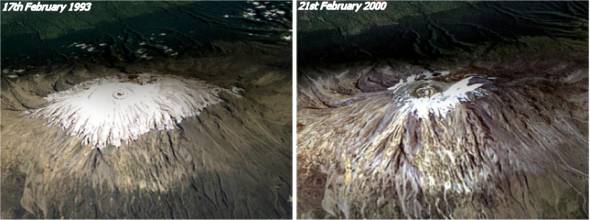The melting snows of Kilimanjaro near the African equator have become a symbol of global warming but is there really a link between the two? Two geophysicists, Philip Mote and Georg Kaser don’t think so. In an article in the journal American Scientific the two scientists have identified other causes.
Global warming is the obvious reason for the world’s melting glaciers which have been in retreat since the end of the mini ice-age over 150 years ago. However equatorial glaciers have a dynamic of their own. At the summit of the tropical African mountains the temperatures are below zero. Snow accumulates over many seasons and transforms into ice. To understand their life cycle one has to understand the energy and mass balances. Since 2000 measures have shown that there has been less snowfall in the region. If the balance is negative and the glacier will loose mass.
However Kilimanjaro is special. The mountain has an ice cap and a number of glaciers. The ice cap, up to 40 meters thick, sits at 5700 meters on the summit of the highest volcanic peak, Kibo. The glaciers descend the sides of Kibo to 5200 meters. At these altitudes temperatures are rarely above -3C, air temperature is therefore not the prime suspect for the melting of Kili’s glaciers. Ice is also lost by a process of sublimation. Energy from sunlight striking the glacier causes ice to transform directly into water vapour which then dissipates in the atmosphere. Increase the amount of sunlight, say to due less cloud cover or a change in the sun’s output due to natural cycles and you increase the amount of ice lost.
The researchers belief this is the principal cause of the loss of ice in the high equatorial glaciers and not an increase in mean temperature identified by Lonnie Thompson and his colleagues in a paper from the Ohio University in 2000. The research says that it is a process that has been happening for more than a century with most of the ice lost before 1953. They blame the configuration of the glacier as well as a change in weather patterns over the Indian Ocean which mean less cloud cover and snowfall.
Posted by
davidof on Wednesday, 12 December, 2007 at 08:31 AM
I read with more than a passing interest the reasons surrounding the decline; the regress of ice on the summit slopes of Kili. I found the two photographs interesting also - in that when I first climbed Kili in 1963 there was nothing like the amount of ice shown in the 17 Feb, 1993. The photo purports to show ice in the upper part of the ‘scree-run’ which is also the line of the final zig-zag track to the summit rim on the Marangu Route. In 1993, there was no ice what-so-ever on those final slopes. The first ice that we encountered was at Gillmans Point and yes we climbed on ice all the way to Uhuru Peak.
Interesting also was my last ascent to Uhuru Peak in 1995 when a three ton deisel driven lorry (passing me at Last Water) which was taking Korean equipment to the start of the Alpine desert. Last Water had been polluted by leaking drums of deisel stockpiled there for this - new, transportation service.
In my opinon Kili has; is being effected by a natural cycle. Keep up with the Lorry service and you can add the-hand-of-man to that natural cycle.
Posted by
Dennis Morrod on Tuesday, 25 December, 2007 at 12:52 PM
Interesting, but the power of the sun and the dearth of cloud cover are part and parcel of the problems inherent in man’s industrialization and resultant technologies applied on Earth. The “natural cycle” is not fully to blame. It is absurd to sugggest anything remotely resembling that argument. Listen, it is quite simple: ecosystems are damaged by introduction of foreign substances, not enhanced by that introduction. I can use a simple analogy. I will pour a bowl of soup for you. But wait, before you eat that soup, I will defecate in it. Please don’t mind the pollution, it’s part of the natural cycle. Eat up. It’s good!
Posted by
Sean O'Neil on Wednesday, 26 December, 2007 at 05:19 PM
Thanks for your interesting comments Dennis. I wonder if the Nasa photographs are misleading? After all it only needs to snow the day before the photograph was taken to give the impression that the whole summit is ice covered. You could take the same kind of photograph of any mountain in the Alps to “prove” what you want.
Posted by
davidof on Friday, 28 December, 2007 at 10:48 AM
Page 1 of 1 pages

